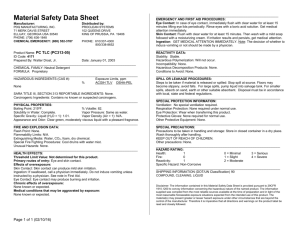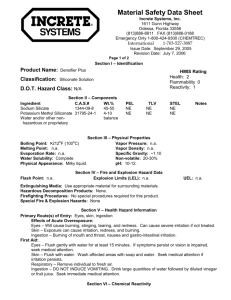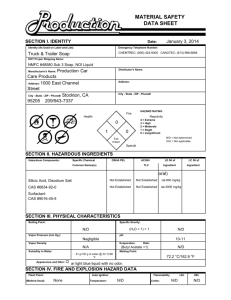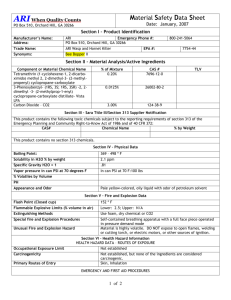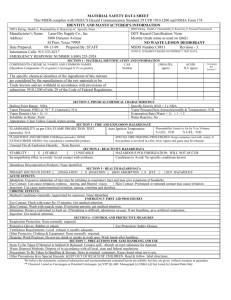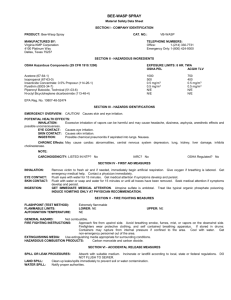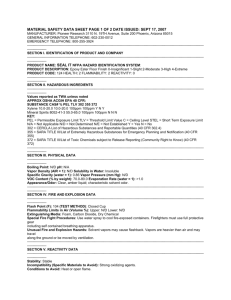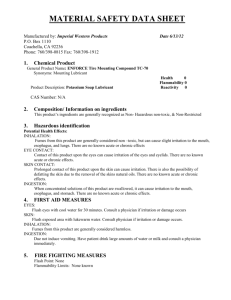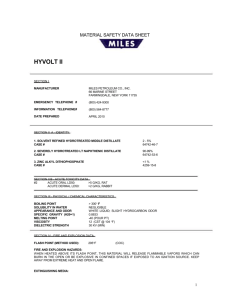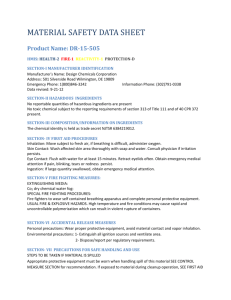effects of over exposure
advertisement
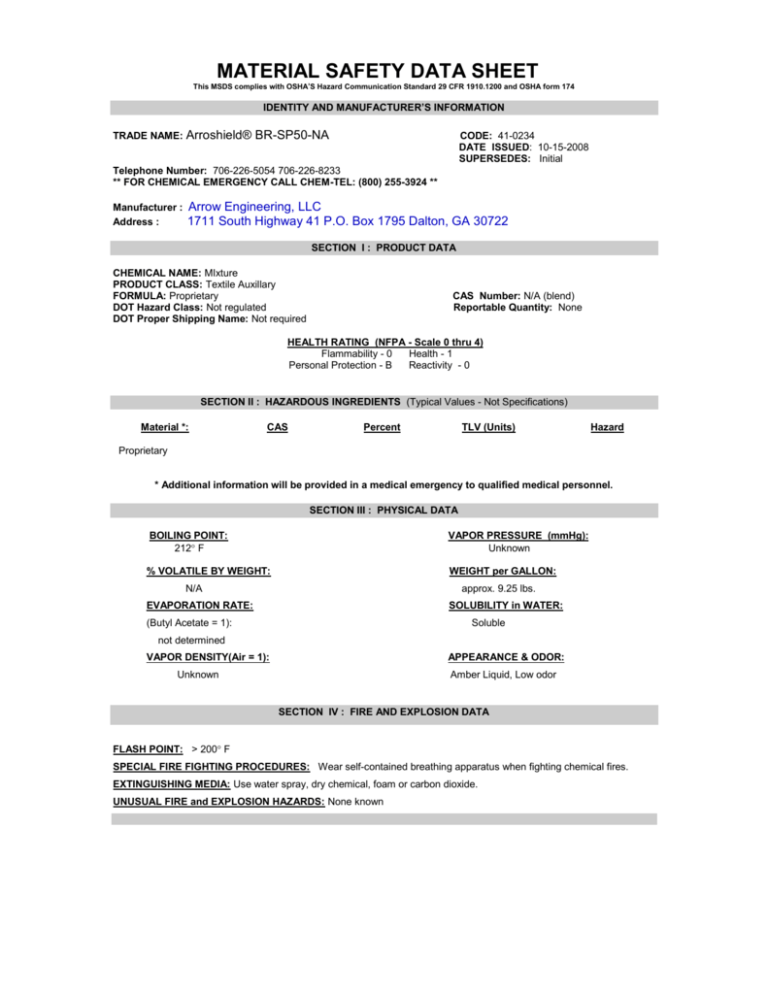
MATERIAL SAFETY DATA SHEET This MSDS complies with OSHA’S Hazard Communication Standard 29 CFR 1910.1200 and OSHA form 174 IDENTITY AND MANUFACTURER’S INFORMATION TRADE NAME: Arroshield® BR-SP50-NA CODE: 41-0234 DATE ISSUED: 10-15-2008 SUPERSEDES: Initial Telephone Number: 706-226-5054 706-226-8233 ** FOR CHEMICAL EMERGENCY CALL CHEM-TEL: (800) 255-3924 ** Manufacturer : Address : Arrow Engineering, LLC 1711 South Highway 41 P.O. Box 1795 Dalton, GA 30722 SECTION I : PRODUCT DATA CHEMICAL NAME: MIxture PRODUCT CLASS: Textile Auxillary FORMULA: Proprietary DOT Hazard Class: Not regulated DOT Proper Shipping Name: Not required CAS Number: N/A (blend) Reportable Quantity: None HEALTH RATING (NFPA - Scale 0 thru 4) Flammability - 0 Health - 1 Personal Protection - B Reactivity - 0 SECTION II : HAZARDOUS INGREDIENTS (Typical Values - Not Specifications) Material *: CAS Percent TLV (Units) Hazard Proprietary * Additional information will be provided in a medical emergency to qualified medical personnel. SECTION III : PHYSICAL DATA BOILING POINT: 212 F VAPOR PRESSURE (mmHg): Unknown % VOLATILE BY WEIGHT: WEIGHT per GALLON: N/A approx. 9.25 lbs. EVAPORATION RATE: SOLUBILITY in WATER: (Butyl Acetate = 1): Soluble not determined VAPOR DENSITY(Air = 1): APPEARANCE & ODOR: Unknown Amber Liquid, Low odor SECTION IV : FIRE AND EXPLOSION DATA FLASH POINT: > 200 F SPECIAL FIRE FIGHTING PROCEDURES: Wear self-contained breathing apparatus when fighting chemical fires. EXTINGUISHING MEDIA: Use water spray, dry chemical, foam or carbon dioxide. UNUSUAL FIRE and EXPLOSION HAZARDS: None known SECTION V : HEALTH HAZARD DATA Threshold Limit Value: See section II: Hazardous Ingredients. EFFECTS OF OVER EXPOSURE Route of Entry: Inhalation, skin, ingestion and eyes. Target Organs: Not Determined Inhalation: Minimal respiratory tract irritation may occur with exposure to a large amount of material. Skin Contact: Prolonged or repeated contact may cause skin dryness or irritation. Eye Contact: Will cause irritation. Ingestion: Swallowing this product may cause gastrointestinal irritation, diarrhea, nausea and vomiting. EMERGENCY AND FIRST AID PROCEDURES Inhalation: Remove to fresh air, if breathing is difficult administer oxygen. Contact a physician Skin Contact: Wash exposed area with soap and water, remove contaminated clothing and launder before reuse. If irritation develops contact a physician. Eye Contact: Flush eyes with water, seek medical attention if eye irritation exists. Ingestion: Do not induce vomiting, dilute by drinking water, if vomiting occurs, administer more water. Never give fluids or induce vomiting if patient is unconscious. Seek immediate medical attention. SECTION VI : REACTIVITY DATA STABILITY: Stable HAZARDOUS DECOMPOSITION PRODUCTS: Combustion may produce CO2 and CO. HAZARDOUS POLYMERIZATION: Will not occur INCOMPATIBILITY( MATERIALS TO AVOID ): Strong oxidizing agents SECTION VII : SPILL OR LEAK PROCEDURES ACCIDENTAL RELEASE MEASURES Small Spill: Soak up with absorbent medium and transfer into suitable container. Large Spill: Get protective equipment. Contain spill and pump into metal drums. Notify appropriate governmental authorities if spill enters sewer or regulated water. Waste Disposal Method Dispose of contaminated absorbent material in accordance with local, State and Federal regulations. SECTION VIII : SPECIAL PROTECTION INFORMATION Engineering Controls: Local ventilation recommended, mechanical ventilation may be used. Protective Equipment: Respiratory Protection: None normally required. Protective Gloves: Rubber or neoprene gloves. Eye Protection: Chemical safety glasses Other: Good housekeeping practices should include making sure all containers are kept closed and properly stored. Properly maintain an eyewash facility in the work area. SECTION IX : SPECIAL PRECAUTIONS Handling and Storage: Handle with due care and avoid personal contact. Since emptied containers retain product residues (vapor, liquid and/or solid), all hazard precautions given in this MSDS must be observed. Other Precautions: Store at normal temperatures and conditions of warehousing. Keep container closed when not in use. Avoid allowing product to freeze. SECTION X : MISCELLANEOUS US FEDERAL REGULATIONS TSCA (Toxic Substances Control Act) Status: This product and/or all of its components are included on the TSCA Inventory of Chemical Substances. SARA 311/312 Hazard Class - 40 CFR 370.2: NONE SARA 313 Components - 40 CFR 372.65: NONE SARA 302 Extremely Hazardous Substances: NONE CERCLA Hazardous Substances: NONE STATE AND LOCAL REGULATIONS Disclaimer: Although reasonable care has been taken in the preparation of this document, we extend no warranties and make no representations as to the accuracy or completeness of the information contained herein, and assume no responsibility regarding the suitability of this information for the user's intended purposes or for the consequences of its use. Individuals should make a determination as to the suitability of the information for their particular purpose(s).

